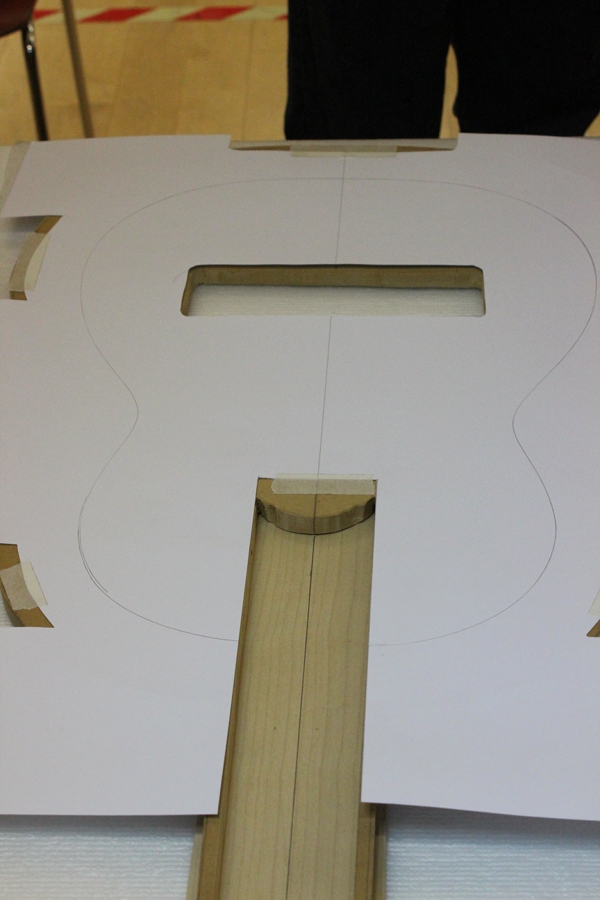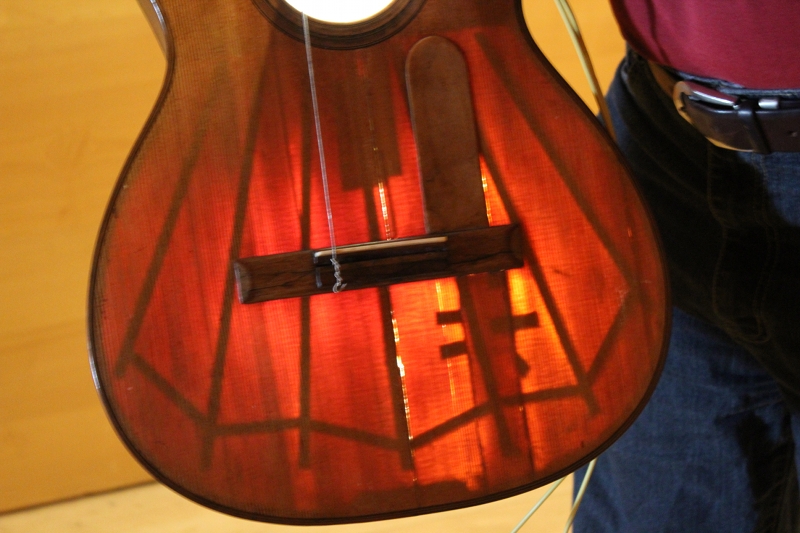Here is a little more from my trip to the Museum in Barcelona. Paul Poletti had the time to lend us a hand with examining one of the guitars. He was working on a visualization system for small, dark spaces and we got to try it out.

Here is a little more from my trip to the Museum in Barcelona. Paul Poletti had the time to lend us a hand with examining one of the guitars. He was working on a visualization system for small, dark spaces and we got to try it out.
A few months ago I was invited to visit the Museum of Music in Barcelona to examine some very interesting guitars. This came about through my luthier friend Antonio Manjon (Barcelona) who is part of a research project being carried out by Marco Antonio Pérez from the Universitat Politècnica de Catalunya – BarcelonaTech. Among other things they are recording the resonances of guitars in different stages of construction as well as those of various historical instruments. The first guitar we examined was the famous paper mache guitar made by Torres in 1862. Although I can’t see either one of us making a copy of this guitar we took enough photos and notes to allow that if the day were ever to come that we wanted to. Here is the bed that we used to trace the outlines of the guitars.  This particular guitar had some nice surprises in store for us, one being the union of the top and sides realized with individual blocks. Quite a few of Torres’ guitars are known to have continous lining and so this was interesting to see. Perhaps the lack of rigid sides meant that linings were impossible to fix to the sides or perhaps Torres was not particularly attached to linings and used “peones” on more of his instruments. Another interesting feature is the structure which takes the place of the typical closing bars. This can be seen in the photo below thanks to the translucent nature of spruce.
This particular guitar had some nice surprises in store for us, one being the union of the top and sides realized with individual blocks. Quite a few of Torres’ guitars are known to have continous lining and so this was interesting to see. Perhaps the lack of rigid sides meant that linings were impossible to fix to the sides or perhaps Torres was not particularly attached to linings and used “peones” on more of his instruments. Another interesting feature is the structure which takes the place of the typical closing bars. This can be seen in the photo below thanks to the translucent nature of spruce.  The last photo here is of the inside of the same guitar and shows both the glue blocks and the finger braces between the fans. The video shows Marco who helped us out by acting as official photographer.
The last photo here is of the inside of the same guitar and shows both the glue blocks and the finger braces between the fans. The video shows Marco who helped us out by acting as official photographer.
Last week a friend came by with a guitar that needed repairing. I agreed to have a look and advise him but I didn’t really have the time to do the work on it. It was a late 80’s Manuel Reyes and the action had been modified by the previous owner. The saddle and nut were shimmed, the bridge was lifting which might have been the reason why the break angle was too low. In order to “fix” that someone had filed grooves in the saddle. The fingerboard was a bit concave (radiussed inwards) and the frets were a bit uneven probably due to that. A hairline crack had developed next to the fretboard too. Someone else did the work in the end and I think he was happy with it. He played it a bit before the repair and I was surprised at how boomy it was. I have experienced a few Reyes before and had never heard that. The owner is Alberto Cuellar, I hope to tell you more about him and his work in China soon as I have asked him to write something for me here. Another interesting thing I learned from this visit is that I need another solution for making videos.
 The original is from 1892 and is number SE 153 as you can see from the label. I saw the original for the first time at a concert and workshop given by the owner Carles Trepat here in Spain. We talked and I looked at and listened carefully to the guitar privately. The idea to make a replica matured over the next year and we arranged to meet to take measurements and photos. In the end I had to travel from Granada to Lerida (near Barcelona) to meet with Carles because although he had been in this area he was busy with concerts and masterclasses. I convinced my master Rolf Eichinger to make the trip with me because I felt I needed his vast knowledge of historical instruments and how to read backwards from what you see on a 100 plus year old guitar. So many things can change like arching, neck angle and even thicknesses over time. We spent almost an entire day with the instrument and I took careful notes and these and other pictures. We reconstructed the original arching of the guitar taking into account the angle of the top where it meets the sides at different points and disregarding the actual arching present today. We took thickness measurements and tried to account for the final sanding and tried to spot repairs and refinishing. The typical situation of slightly thinner perimeter usually indicates the above and not a desire by the maker to leave that part thinner.
The original is from 1892 and is number SE 153 as you can see from the label. I saw the original for the first time at a concert and workshop given by the owner Carles Trepat here in Spain. We talked and I looked at and listened carefully to the guitar privately. The idea to make a replica matured over the next year and we arranged to meet to take measurements and photos. In the end I had to travel from Granada to Lerida (near Barcelona) to meet with Carles because although he had been in this area he was busy with concerts and masterclasses. I convinced my master Rolf Eichinger to make the trip with me because I felt I needed his vast knowledge of historical instruments and how to read backwards from what you see on a 100 plus year old guitar. So many things can change like arching, neck angle and even thicknesses over time. We spent almost an entire day with the instrument and I took careful notes and these and other pictures. We reconstructed the original arching of the guitar taking into account the angle of the top where it meets the sides at different points and disregarding the actual arching present today. We took thickness measurements and tried to account for the final sanding and tried to spot repairs and refinishing. The typical situation of slightly thinner perimeter usually indicates the above and not a desire by the maker to leave that part thinner.  Rolf was always obsessed with the harmony and aesthetics of the body shapes of the great makers’ guitars and his extensive experience in reconstructing those curves with compas and rule allowed me to make an accurate mold which made for a symmetrical and blanced body form; original but without the typical variations which are usually present in historical instruments.
Rolf was always obsessed with the harmony and aesthetics of the body shapes of the great makers’ guitars and his extensive experience in reconstructing those curves with compas and rule allowed me to make an accurate mold which made for a symmetrical and blanced body form; original but without the typical variations which are usually present in historical instruments.
My intention with this guitar is to make a perfect copy and at the same time to get as close to the sound of the original as possible. I think to do both is impossible because of the time that has passed since 1892. In order to get closer to the sound of the original I work slightly thinner and try to use my oldest and lightest-weight wood.  I even try to use similar looking top wood. My philosophy of the copy is that the aesthetics and measurements should be the same but when it comes to techniques and methods which are not evident in the guitar I don’t trust what the “experts” claim were the methods of Torres. Rather I think that the closest we can come to his methods is to follow the tradition he helped establish and to use those techniques still alive today.
I even try to use similar looking top wood. My philosophy of the copy is that the aesthetics and measurements should be the same but when it comes to techniques and methods which are not evident in the guitar I don’t trust what the “experts” claim were the methods of Torres. Rather I think that the closest we can come to his methods is to follow the tradition he helped establish and to use those techniques still alive today.
Anything I have modified has been to make the guitar a better tool for the musician. Things like: some of the frets were not perfectly placed and the bridge compensation was not right on the original, since my guitar is thought to be very comfortable I carve the neck to a similar shape on this model, I make a small lip on the back of the bridge as added insurance against the bridge lifting. The weight of the original was 1225g and the weight of my first copy (maple) was 1232. That was just chance but it was satisfying. I don’t worry about a specific weight or body frequence the way some makers do but I do try to keep the guitar light. This guitar has taught me so much, I find myself needing to invent methods to achieve certain effects (on the rosette for example) and then I realize that Torres MUST have done it the same way so I have invented nothing.
I am sure you are familiar with the technique of placing a light bulb inside the guitar to see the fan bracing. However, with very old guitars the top is not nearly so translucent so I had to doctor this shot a bit to get the fans to show up clearly. They were perfectly visible for the purpose of making my drawing but the original photo was not suitable for posting.
Here is a video of Trepat playing the original.
Javier Riba was in town this week for some fret work and while he waited he was working on the pieces for his upcoming concert in Italy. I asked him to record something for me on the Torres copy and the same thing on a cypress concert guitar. I made the Torres copy in 2005 and the cypress in 2010. The video was made with a digital still cam, there was a thunderstorm, and a few car noises so sound is about as bad as it gets, let’s say this is just for fun. Tárrega’s Prelude No. 1
Cypress concert guitar
Maple Torres copy